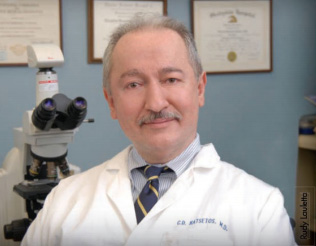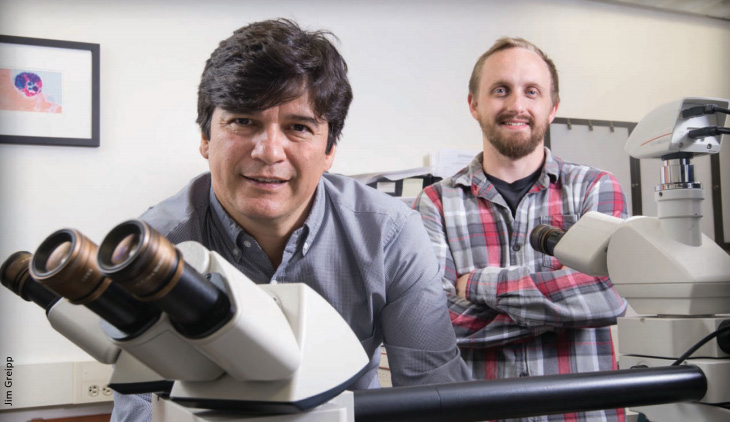Teaming Up to Fight Brain Tumors

Christos D. Katsetos, MD, PhD
Cell metabolism and alterations in the microtubule cytoskeleton, a network of structural proteins with diverse cellular functions, offer important clues to understanding cancer behaviors and how cancer cells differ from their healthy counterparts. New research being conducted by biochemist Mauricio Reginato, PhD, and physician/clinical researcher Christos D. Katsetos, MD, PhD, is elucidating exactly how brain tumors grow and invade the surrounding brain and what can be done to curtail cancer growth and spread.
The cross-disciplinary partnership began two years ago with a serendipitous turn of events. Since arriving at Drexel, Reginato had been studying breast cancer, and he had focused his research on an enzyme called OGT (O-GlcNAc transferase), which was shown to be sensitive to changes in glucose. "We found that OGT is highly elevated in breast cancer, but when we turned off this enzyme, the breast cancer cells stopped growing and eventually died," says Reginato, director of Drexel's Graduate Program in Cancer Biology.
More recently, Reginato read an intriguing paper that suggested that OGT might also play an important role in brain cancer. Days later, he received an email from Katsetos, requesting his participation in a research project. He'd never met Katsetos and was unaware until then that their research interests aligned.
Katsetos, who holds joint appointments in pediatrics and pathology at the College of Medicine and St. Christopher's Hospital for Children, has spent more than 25 years studying the cellular and molecular mechanisms associated with the development and progression of brain tumors in children and adults. During the past decade, his work has focused on high-grade gliomas/glioblastoma.

Mauricio Reginato, PhD, and Zachary Bacigalupa
High-grade gliomas are of particular concern to Katsetos because they are difficult to contain and refractory to current treatment modalities. "Despite major advances in the genomics and epigenomics of brain tumors, these tumors have a dismal prognosis, and no major progress has been made in their treatment in the past 10 years or so," Katsetos says.
The project Katsetos was proposing involved looking at a different protein in brain cancer, called spastin. Spastin, an enzyme that severs microtubules, was previously found to be overexpressed in high-grade gliomas/glioblastoma by Katsetos and collaborators, including Reginato and neurobiologist Peter W. Baas, PhD, professor and director of Drexel's Graduate Program in Neuroscience.* Earlier work by Baas, who has studied microtubule-severing proteins extensively, suggested that spastin could be a powerful target to curtail the motility and invasion of cancer cells.
The goal of the new study would be to identify novel molecular targets for the development of adjuvant therapies for cancer, particularly brain tumors. "As soon as we met and discussed our ideas, we realized we could complement each other very well," Reginato says. In addition, Baas would lend his expertise in spastin. "We felt from the outset that this synergy would help us achieve a new interdisciplinary and comprehensive approach to cancer research," Katsetos adds.
The first step, with funding from the Commonwealth Universal Research Enhancement (CURE) program, was creating a preclinical animal model of glioblastoma. The first-ever orthotopic xenograft model launched at Drexel, which implants human glioblastoma cell lines into the brains of immunocompromised mice, allowed the team to study in vivo and ex vivo the effects of OGT or spastin suppression on cancer growth and spread.
Before long, their hypothesis was confirmed. "We could see that when we reduced the expression of OGT, we blocked the growth of glioblastoma," Reginato says. "We could confirm that OGT was regulating the metabolism, both glucose and lipids, in the brain." And, according to Katsetos, "a similar trend, leading to abrogation of glioblastoma growth, was observed, both in vitro and in vivo, after suppressing the expression of spastin."
The CURE support has underwritten the initial proof-of-concept work, but the team is now looking for more funding from outside sources to take the research to its next stage. "Having been able to show that suppressing the expression of OGT and spastin had remarkable inhibitory effects on tumor growth, we feel we have some very exciting and promising preliminary data with potential therapeutic implications," Katsetos says. "Our research approach is somewhat unique in that we are investigating both basic cellular mechanisms and translational aspects together, but it has served us well."
Along with additional collaborators, they have already developed a drug for OGT, which is currently being tested in animal models. "We know there's no single drug that can kill cancer, but we would like to see this drug used as a first line of treatment to sensitize tumors to radiation therapy," Reginato says. "The best case scenario, of course, would be to move this into clinical trials."
Katsetos believes that with the use of computer modeling and translational bioinformatics, a spastin-selective drug may well be on the immediate horizon. "Certainly, it's a matter of years rather than months, but the initial effects are forthcoming, and our data lend credence to our conceptual approach and overall hypotheses."
Reginato credits their momentum to the help of graduate students Christina Ferrer (now a postdoctoral fellow at Harvard Medical School) and Zachary Bacigalupa. In fact, Reginato says that it was the high quality of graduate students that drew him to Drexel in the first place. "The truth is, professors and medical doctors can come up with great ideas, but you need people to help you actually carry them out in the laboratory," he says. "Drexel's top-notch graduate students have been crucial to the success of this research."
The collaboration across research disciplines has also been uniquely rewarding, Reginato says. "With Christos' help, we were able to look at a tissue microarray and compare normal brain cells to those of a glioblastoma patient. When we saw that the OGT was highly elevated in brain cancers, that gave us the rationale to then try to target it in the glioblastoma cells. In our collaboration, we can confirm things we typically only see in tissue cultures in real patients."
The excitement around the project comes not just from achieving great initial results but also from the satisfaction of auspicious teamwork. "We know that collaborations within institutions tend to be the most effective, and to the institution's credit, Drexel has given well-rounded basic scientists like Mauricio and physician-scientists like myself the opportunity to take on formidable problems intramurally," Katsetos says. "No doubt we are stronger working together."
*"Emerging Microtubule Targets in Glioma Therapy," an article in Seminars in Pediatric Neurology, April 2015. Additional authors included Agustin Legido, MD, PhD, professor of pediatrics and neurology at Drexel and chief of the Section of Pediatric Neurology at St. Christopher's Hospital for Children.
Back to Top